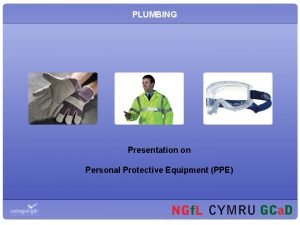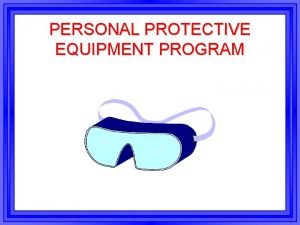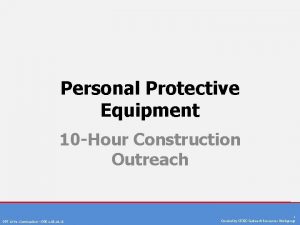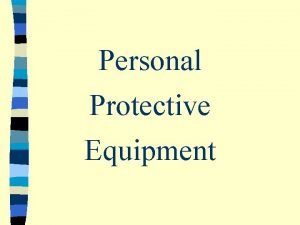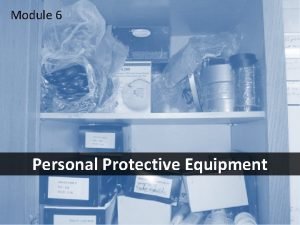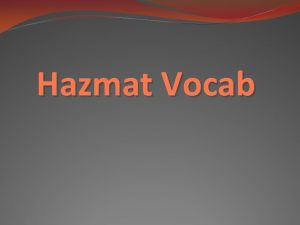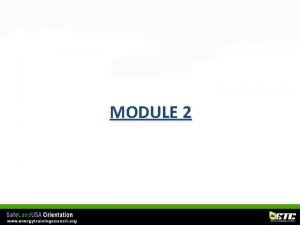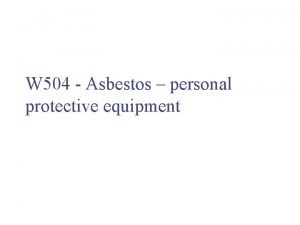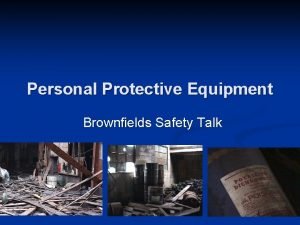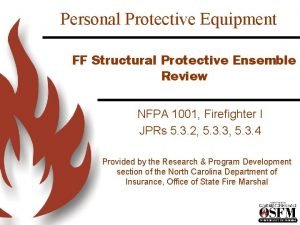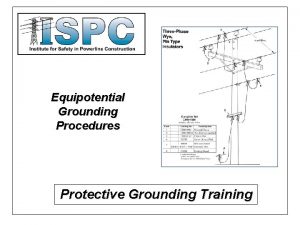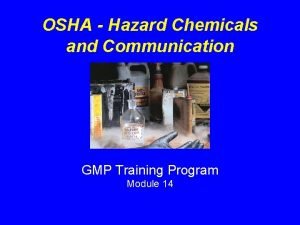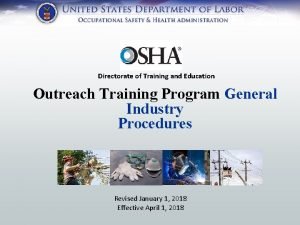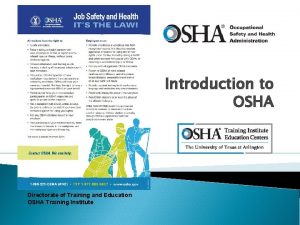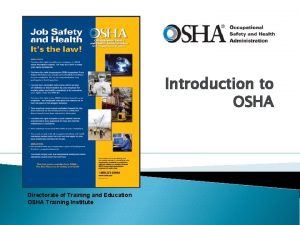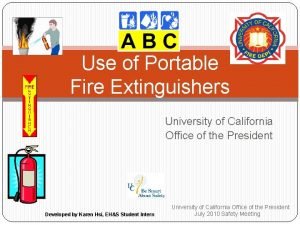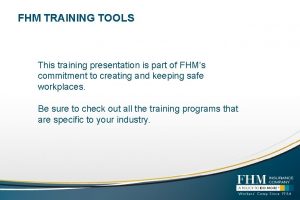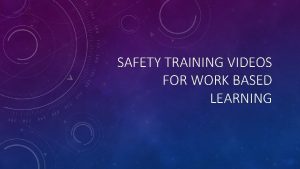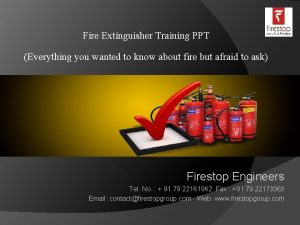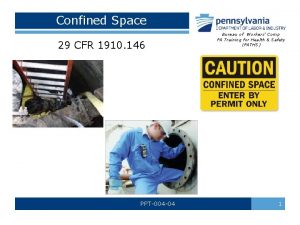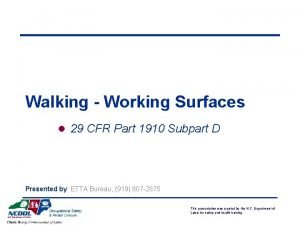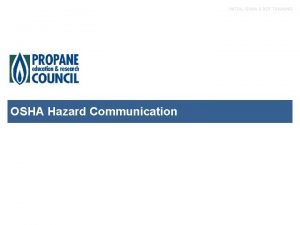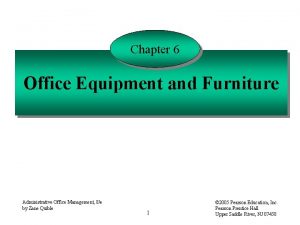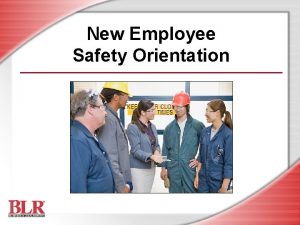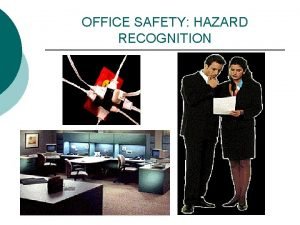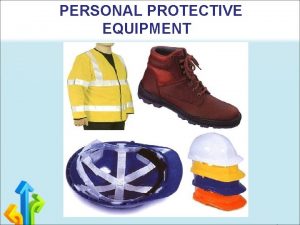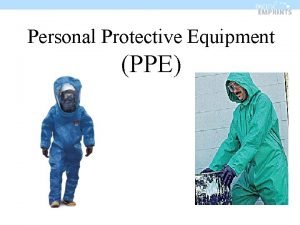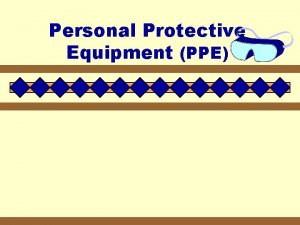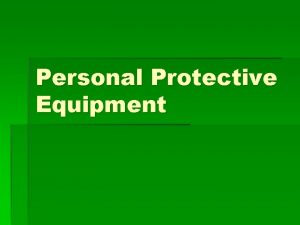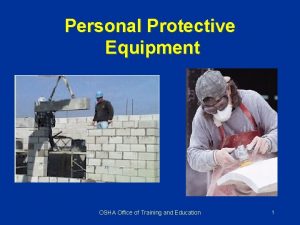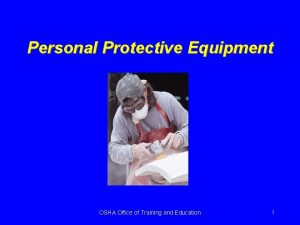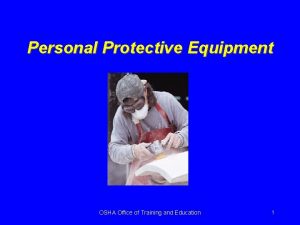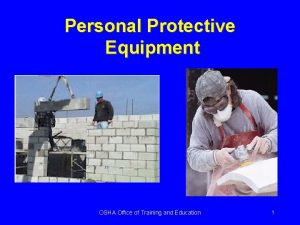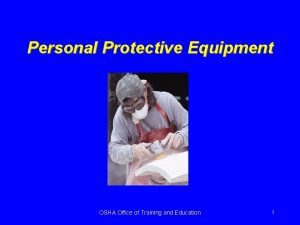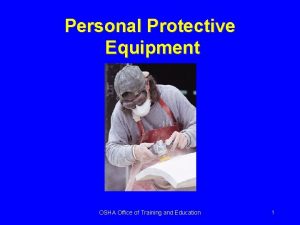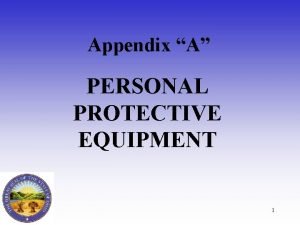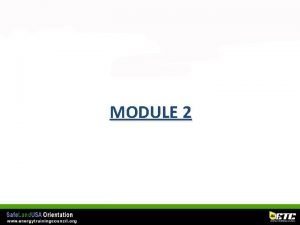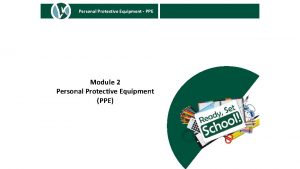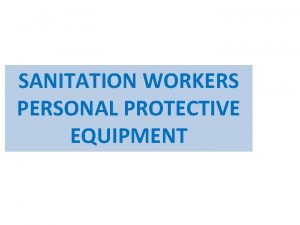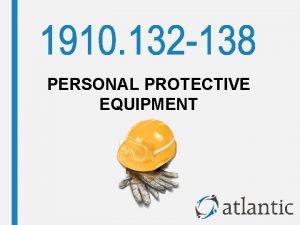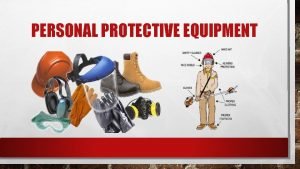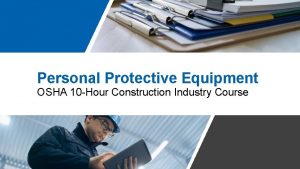Personal Protective Equipment OSHA Office of Training and




































- Slides: 36

Personal Protective Equipment OSHA Office of Training and Education 1

Protecting Employees from Workplace Hazards • • • Employers must protect employees from workplace hazards such as machines, hazardous substances, and dangerous work procedures that can cause injury Employers must: Ø Use all feasible engineering and work practice controls to eliminate and reduce hazards Ø Then use appropriate personal protective equipment (PPE) if these controls do not eliminate the hazards. Remember, PPE is the last level of control! OSHA Office of Training and Education 2

Payment for PPE When PPE is required to protect employees, it must be provided by the employer at no cost to employees, except for specific items, such as: • Safety-toe footwear, • Prescription safety eyewear, • Everyday clothing and weather-related gear, and • Logging boots OSHA Office of Training and Education 3

Engineering Controls If. . . The machine or work environment can be physically changed to prevent employee exposure to the potential hazard, Then. . . The hazard can be eliminated with an engineering control. OSHA Office of Training and Education 4

Engineering Controls (cont’d) Examples. . . • • • Initial design specifications Substitute less harmful material Change process Enclose process Isolate process Ventilation OSHA Office of Training and Education 5

Work Practice Controls If. . . Employees can be removed from exposure to the potential hazard by changing the way they do their jobs, Then. . . The hazard can be eliminated with a work practice control. OSHA Office of Training and Education 6

Work Practice Controls (cont’d) Examples. . . • • Use of wet methods to suppress dust Personal hygiene Housekeeping and maintenance Job rotation of workers OSHA Office of Training and Education 7

Examples of PPE • • Eye - safety glasses, goggles Face - face shields Head - hard hats Feet - safety shoes Hands and arms - gloves Bodies - vests Hearing - earplugs, earmuffs OSHA Office of Training and Education 8

Establishing a PPE Program • Sets out procedures for selecting, providing and using PPE as part of an employer’s routine operation • First -- assess the workplace to determine if hazards are present, or are likely to be present, which necessitate the use of PPE • Once the proper PPE has been selected, the employer must provide training to each employee who is required to use PPE OSHA Office of Training and Education 9

Training Employees required to use PPE must be trained to know at least the following: • When PPE is necessary • What type of PPE is necessary • How to properly put on, take off, adjust, and wear • Limitations of the PPE • Proper care, maintenance, useful life and disposal OSHA Office of Training and Education 10

Eye Protection OSHA Office of Training and Education 11

What are some of the causes of eye injuries? • Dust and other flying particles, such as metal shavings or sawdust • Molten metal that might splash • Acids and other caustic liquid chemicals that might splash • Blood and other potentially infectious body fluids that might splash, spray, or splatter • Intense light such as that created by welding and lasers OSHA Office of Training and Education 12

Safety Spectacles • Made with metal/plastic safety frames • Most operations require side shields • Used for moderate impact from particles produced by such jobs as carpentry, woodworking, grinding, and scaling OSHA Office of Training and Education 13

Goggles • Protect eyes, eye sockets, and the facial area immediately surrounding the eyes from impact, dust, and splashes • Some goggles fit over corrective lenses OSHA Office of Training and Education 14

Welding Shields Protect eyes from burns caused by infrared or intense radiant light, and protect face and eyes from flying sparks, metal spatter, and slag chips produced during welding, brazing, soldering, and cutting OSHA Office of Training and Education 15

Laser Safety Goggles Protect eyes from intense concentrations of light produced by lasers. OSHA Office of Training and Education 16

Face Shields • Protect the face from nuisance dusts and potential splashes or sprays of hazardous liquids • Do not protect employees from impact hazards OSHA Office of Training and Education 17

Head Protection OSHA Office of Training and Education 18

What are some of the causes of head injuries? • Falling objects • Bumping head against fixed objects, such as exposed pipes or beams • Contact with exposed electrical conductors OSHA Office of Training and Education 19

Classes of Hard Hats Class G (formerly Class A)1 • General service (e. g. , mining, building construction, shipbuilding, lumbering, and manufacturing) • Good impact protection but limited voltage protection Class E (formerly Class B)1 • Electrical work • Protect against falling objects, high-voltage shock/burns Class C • Designed for comfort, offer limited protection • Protects heads that may bump against fixed objects, but do not protect against falling objects or electrical shock 1 Per ANSI Z 89. 1 -1997 OSHA Office of Training and Education 20

Hearing Protection OSHA Office of Training and Education 21

Examples of Hearing Protectors Earmuffs Earplugs OSHA Office of Training and Education Canal Caps 22

Foot Protection OSHA Office of Training and Education 23

What are some of the causes of foot injuries? • Heavy objects such as barrels or tools that might roll onto or fall on employees’ feet • Sharp objects such as nails or spikes that might pierce the soles or uppers of ordinary shoes • Molten metal that might splash on feet • Hot or wet surfaces • Slippery surfaces OSHA Office of Training and Education 24

Safety Shoes • Have impact-resistant toes and heat-resistant soles that protect against hot surfaces common in roofing, paving, and hot metal industries • Some have metal insoles to protect against puncture wounds • May be designed to be electrically conductive for use in explosive atmospheres, or nonconductive to protect from workplace electrical hazards OSHA Office of Training and Education 25

Metatarsal Guards A part of the shoes or strapped to the outside of shoes to protect the instep from impact and compression OSHA Office of Training and Education 26

Hand Protection OSHA Office of Training and Education 27

What are some of the hand injuries you need to guard against? • • Burns Bruises Abrasions Cuts Punctures Fractures Amputations Chemical Exposures OSHA Office of Training and Education 28

Types of Gloves Norfoil laminate resists permeation and breakthrough by an array of toxic/hazardous chemicals. Butyl provides the highest permeation resistance to gas or water vapors; frequently used for ketones (M. E. K. , Acetone) and esters (Amyl Acetate, Ethyl Acetate). OSHA Office of Training and Education 29

Types of Gloves (cont’d) Viton is highly resistant to permeation by chlorinated and aromatic solvents. Nitrile provides protection against a wide variety of solvents, harsh chemicals, fats and petroleum products and also provides excellent resistance to cuts, snags, punctures and abrasions. OSHA Office of Training and Education 30

Types of Gloves (cont’d) Kevlar protects against cuts, slashes, and abrasion. Stainless steel mesh protects against cuts and lacerations. OSHA Office of Training and Education 31

Body Protection OSHA Office of Training and Education 32

What are some of the causes of body injuries? • • • Intense heat Splashes of hot metals and other hot liquids Impacts from tools, machinery, and materials Cuts Hazardous chemicals Contact with potentially infectious materials, like blood • Radiation OSHA Office of Training and Education 33

Body Protection Cooling Vest Sleeves and Apron OSHA Office of Training and Education 34

Body Protection Coveralls Full Body Suit OSHA Office of Training and Education 35

Summary Employers must implement a PPE program where they: • Assess the workplace for hazards • Use engineering and work practice controls to eliminate or reduce hazards before using PPE • Select and provide appropriate PPE at no cost* to employees to protect them from hazards that cannot be eliminated • Inform employees why the PPE is necessary and when it must be worn • Train employees how to use and care for their PPE and how to recognize deterioration and failure • Require employees to wear selected PPE in the workplace *See 72 FR 64341, Nov. 5, 2007 for exceptions OSHA Office of Training and Education 36
 Plumbing presentation
Plumbing presentation Ppe program
Ppe program Protective equipment in sports ppt
Protective equipment in sports ppt Welding chapter 2
Welding chapter 2 Ppe list
Ppe list Personal protective equipment for farmers
Personal protective equipment for farmers A worker mixing chemicals must not wear
A worker mixing chemicals must not wear Ignorganic chemical equipment
Ignorganic chemical equipment Personal protective equipment vocabulary
Personal protective equipment vocabulary Summary of personal protective equipment
Summary of personal protective equipment Personal protective equipment pictograms
Personal protective equipment pictograms Personal protective equipment matrix
Personal protective equipment matrix Asbestos personal protective equipment
Asbestos personal protective equipment Ppe for plumbing
Ppe for plumbing Personal protective equipment safety talk
Personal protective equipment safety talk Importance of using personal protective equipment
Importance of using personal protective equipment Special protective equipment used in firefighting except
Special protective equipment used in firefighting except Personal protective factor
Personal protective factor Equipotential grounding
Equipotential grounding Osha hazard and ghs training regulation cfr 1910
Osha hazard and ghs training regulation cfr 1910 Osha directorate of training and education
Osha directorate of training and education Osha directorate of training and education
Osha directorate of training and education Osha directorate of training and education
Osha directorate of training and education Cal osha fire extinguisher
Cal osha fire extinguisher Osha yard tractor training
Osha yard tractor training Osha training videos
Osha training videos Firefighter motto
Firefighter motto 1910 confined space
1910 confined space Osha handrail requirements 2017
Osha handrail requirements 2017 Osha hazard communication initial training
Osha hazard communication initial training Administrative office equipment
Administrative office equipment Debit credit rules
Debit credit rules Office equipment
Office equipment Office equipment depreciation life
Office equipment depreciation life Office equipment
Office equipment Office equipment definition
Office equipment definition Que es adorar?
Que es adorar?
